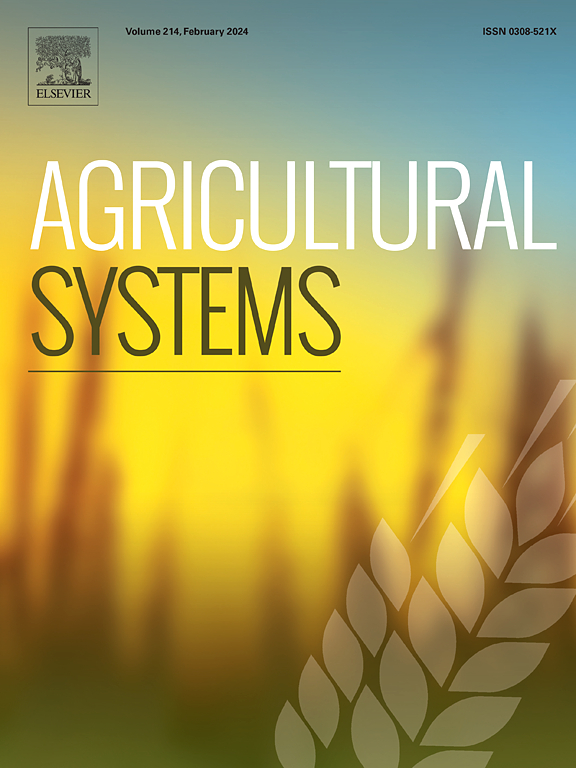Optimizing rice management to reduce methane emissions and maintain yield with the CSM-CERES-rice model
IF 6.1
1区 农林科学
Q1 AGRICULTURE, MULTIDISCIPLINARY
引用次数: 0
Abstract
CONTEXT
Irrigated paddy fields are major contributors to methane (CH4) emissions, significantly impacting global warming. Flood irrigation, the traditional method for rice cultivation, significantly increases water consumption and CH4 emissions.
OBJECTIVE
The primary objective of this study was to quantify the benefits of deficit irrigation in reducing CH4 emissions and maintaining yield compared to traditional flood irrigation using a systems analysis approach.
METHODS
The field study was conducted from May to August in both 2015 and 2016 at the Rice Research Institute in Amol, northern Iran. The site has a warm temperate climate, with the soil characterized as silty clay loam. The data collected during these two years were used for the calibration and evaluation of the CSM-CERES-Rice model. Calibration was performed using the data collected in 2016 while the model's performance was evaluated using data collected in 2015. Following model calibration and evaluation, a seasonal analysis was employed to assess alternative management practices for single growing seasons. This analysis feature of DSSAT allowed us to evaluate alternate management scenarios with the model using 35 years of long-term historical daily weather data from 1984 to 2018 obtained from a local weather station.
RESULTS AND CONCLUSIONS
The simulation revealed that early rice planting, in April or May, yielded the highest production and the lowest CH₄ emissions, when using the direct seeding method. This strategy resulted in a 15 % increase in yield, 13 % better irrigation efficiency, and a 9 % reduction in CH₄ emissions compared to transplanting. Among tillage systems, no-tillage further reduced CH₄ emissions by 29 % without compromising yield or irrigation efficiency. Although sowing depth did not significantly affect CH₄ emissions or yield, an optimal depth of 10–15 cm was identified. Additionally, maintaining a plant population of 10 transplants per hill exhibited the lowest CH₄ emissions compared to higher plant populations. Higher nitrogen fertilization rates increased both yield and CH₄ emissions. In conclusion, the best approach among different strategies was early cultivation for direct-seeded rice coupled with a nitrogen fertilizer rate of 250 kg ha−1, resulting in both the highest yield and the lowest emissions simultaneously.
SIGNIFICANCE
The findings from this study offer a comprehensive exploration, identifying specific agronomic practices that optimize rice cultivation by enhancing yield, conserving water, and significantly reducing CH4 emissions, thereby providing actionable insights for policymakers and farmers in fostering sustainable agriculture.

求助全文
约1分钟内获得全文
求助全文
来源期刊

Agricultural Systems
农林科学-农业综合
CiteScore
13.30
自引率
7.60%
发文量
174
审稿时长
30 days
期刊介绍:
Agricultural Systems is an international journal that deals with interactions - among the components of agricultural systems, among hierarchical levels of agricultural systems, between agricultural and other land use systems, and between agricultural systems and their natural, social and economic environments.
The scope includes the development and application of systems analysis methodologies in the following areas:
Systems approaches in the sustainable intensification of agriculture; pathways for sustainable intensification; crop-livestock integration; farm-level resource allocation; quantification of benefits and trade-offs at farm to landscape levels; integrative, participatory and dynamic modelling approaches for qualitative and quantitative assessments of agricultural systems and decision making;
The interactions between agricultural and non-agricultural landscapes; the multiple services of agricultural systems; food security and the environment;
Global change and adaptation science; transformational adaptations as driven by changes in climate, policy, values and attitudes influencing the design of farming systems;
Development and application of farming systems design tools and methods for impact, scenario and case study analysis; managing the complexities of dynamic agricultural systems; innovation systems and multi stakeholder arrangements that support or promote change and (or) inform policy decisions.
 求助内容:
求助内容: 应助结果提醒方式:
应助结果提醒方式:


